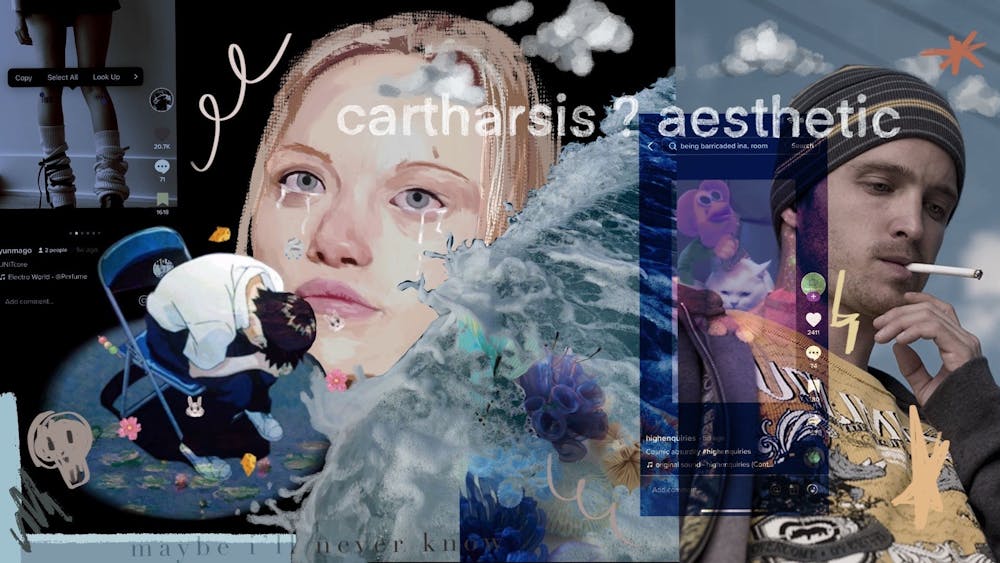TikTok is full of hashtags that end in “–core”: cottagecore, balletcore, normcore. Each of these “cores” relates to an aesthetic or a micro–trend. For example, videos under #balletcore show young women, who are mostly not actual ballerinas, dressing in soft pink, frilly pieces and tying their hair with ribbon. A “–core” on TikTok refers to a certain aesthetic that fringes on being disingenuous.
Corecore embodies this spirit: Know Your Meme explains that corecore makes “a ‘core’ out of the collective consciousness of all ‘cores.’” Corecore uses videos we see on an everyday basis that, alone, are insignificant, and stitches them together to evoke emotion—usually sadness or loneliness. The people making corecore videos are not necessarily experts in human culture or emotion, but make content that comments on and evokes these feelings nonetheless. Corecore has recently taken the internet by storm, with the hashtag having 1.4 billion views on TikTok alone.
It’s hard to truly understand what corecore is because, as with every TikTok trend, the idea seems to change with every video. There isn’t one singular set of requirements for a video to be corecore; it seems that anything, if it’s weird and sad and deemed “real” enough, can be corecore. TikTok user @masonoelle—who is credited as one of the earliest adopters of corecore—posted a statement to TIME magazine on their Instagram, stating that “The whole point of this stuff is to create something that can’t be categorized, commodified, made into clickbait, or moderated—something immune to the functions of control that dictate the content we consume and the ideas we are allowed to hold.”
Chance Townsend, an editor for Mashable, writes that corecore videos originally sought “to push a certain message, with either an anti–capitalist or environmentalist slant," and these origins are still present.
For example, one video under the hashtag opens with Doja Cat’s bedazzled look from Paris Fashion Week, her face painted red and her bodycovered in 30,000 Swarovski crystals. The video then cuts to a clip of someone explaining that she “can’t afford to drink, can’t afford to get food, can’t even afford a hamburger.” Working a regular 9–5 is no longer paying the bills. The dichotomy of these two clips evokes an unpleasant, visceral response. In this way, corecore nudges social unrest, making artful commentary on society’s issues.
Here, technology and our society’s constant need for grander, bigger, and better in part played a role in Doja Cat’s exorbitant look. Meanwhile, the rest of us struggle to afford basic necessities.
Another video under #corecore received 7.0 million views and 1.9 million likes. It starts with a screen recording of someone quickly flipping through the TikTok app, overlaid with a screeching “beeeeep” and a viral TikTok sound. The screen flips faster and faster, then cuts to a black screen with white words: “Wake up.”
Thhe music changes to slow piano, and we see clips of people in moving chairs drinking soda from WALL–E, clips of everyday people on their phones in the streets, the billboards of New York, and Mark Zuckerberg speeches. Someone warns that our era now may be “the last interaction we had, and there’s something beautiful in that.” This encompasses the alluring nihilism corecore seems to offer: We are slipping toward a depressing, lonely world in which everything is the same and nothing truly matters.
This video more directly accuses technology as the cause of our society’s pitfalls. People are no longer connected to each other, no longer able to live in the moment.
Corecore touches on other subjects as well—yet another TikTok under the hashtag shows clips of interviews with men who are asked to rate themselves on a scale from one to ten. They reply with low ratings. It then shows an interview with Billie Eilish, who asks, “Why is every pretty girl with a horrible looking man?” The video itself is self–pitying, frustrated at the way that society has decided to portray men, and corecore serves as a method of letting out those frustrations.
There are corecores that comment on the experiences of women, too: the dangers of being a woman, of how women of different races are fetishized, of women deemed “submissive” being more attractive. One remarks on how women are not treated as humans—how our culture allows everyone to view women as “lesser than” without consequence.
Corecore is ultimately commentary about the state of our world, about how technology and our culture is slowly ruining us. It’s a result of how disconnected people in our culture feel—technology, hate, and fear have taken over so much of our lives. Technology is scary. We're only starting to feel its extremely harmful repercussions, and it’s clear that those effects will only become more pronounced with time.
Corecore is a symptom of our technological ailments. It juxtaposes the “all is well” style of TikToks that are aesthetically pleasing or more humorous. Despite its pessimistic tone, perhaps viewing corecore provides a sort of catharsis, second only to fixing the problems raised by technology itself.







